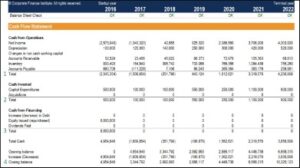Double Entry: What It Means in Accounting and How Its Used
Bookkeeping

He currently researches and teaches economic sociology and the social studies of finance what’s the difference between a credit memo credit and a refund at the Hebrew University in Jerusalem.
The total debit balance of $30,000 matches the total credit balance of $30,000. With double-entry accounting, when the good is purchased, it records an increase in inventory and a decrease in assets. When the good is sold, it records a decrease in inventory and an increase in cash (assets). Double-entry accounting provides a holistic view of a company’s transactions and a clearer financial picture. To account for the credit purchase, a credit entry of $250,000 will be made to accounts payable. The debit entry increases the asset balance and the credit entry increases the notes payable liability balance by the same amount.
Although single-entry bookkeeping is simpler, it’s not as reliable as double-entry and isn’t a suitable accounting method for medium to large businesses. Double-entry accounting is a system of bookkeeping where every financial transaction is recorded in at least two accounts. A double-entry system provides a check and balance for each transaction, which helps ensure accuracy and prevent fraud.
Types of Business Accounts
The Credit Card Due sub-ledger would include a record of the other half of the entry, a credit for $5,000. The general ledger would have two lines added to it, showing both the debit and credit for $5,000 each. If Lucie opens a new grocery store, she may start the business by contributing some of her own savings of $100,000 to the company.
- To make things a bit easier, here’s a cheat sheet for how debits and credits work under the double-entry bookkeeping system.
- As a small business owner, knowing which accounting practices you should use can be confusing.
- For very small businesses with only a handful of transactions, single-entry bookkeeping can be sufficient for their accounting needs.
- A batch of postings may include a large number of debits and credits, but the total of the debits must always equal the total of credits.
- A simple guide to accounting, recordkeeping, and taxes for property management businesses.
Example 1: Business Purchases Using Credit
This method provides a more complete picture of a business’s finances, and is typically used by larger businesses. When you generate a balance sheet in double-entry bookkeeping, your liabilities and equity (net worth or “capital”) must equal assets. In this case, the compare and contrast job order costing and process costing asset that has increased in value is your Inventory.
Which of these is most important for your financial advisor to have?
As a result, multiple sectors of the same account are impacted at the same time. As is purchase ledger control account a debit or credit a result, the organization’s employees and officers are aware of the account manipulation. One party benefits from the transaction while the other party benefits equally. The Double Entry System is the most dependable, scientific, comprehensive, and self-contained accounting system. His first book on accounting was “Summa de Arithmetica, Geometria, Proportianet Proportionalita”.
This article compares single and double-entry bookkeeping and explains the pros and cons of both systems. A financial professional will offer guidance based on the information provided and offer a no-obligation call to better understand your situation. Our team of reviewers are established professionals with decades of experience in areas of personal finance and hold many advanced degrees and certifications. At Finance Strategists, we partner with financial experts to ensure the accuracy of our financial content.
Debits decrease revenue account balances, while credits increase their balances. To be in balance, the total of debits and credits for a transaction must be equal. Debits do not always equate to increases, and credits do not always equate to decreases.

Recording multiple transactions that require both credit and debit entries can be time-consuming and lead to mistakes. It is recommended to use an accountant for your business or accounting software to ensure that all transactions are recorded correctly. The software lets a business create custom accounts, like a “technology expense” account to record purchases of computers, printers, cell phones, etc. You can also connect your business bank account to make recording transactions easier. There are two different ways to record the effects of debits and credits on accounts in the double-entry system of bookkeeping. They are the Traditional Approach and the Accounting Equation Approach.
When all the accounts in a company’s books have been balanced, the result is a zero balance in each account. This is reflected in the books by debiting inventory and crediting accounts payable. For example, a copywriter buys a new laptop computer for her business for $1,000. She credits her technology expense account for $1,000 and debits her cash account for $1,000.
hello